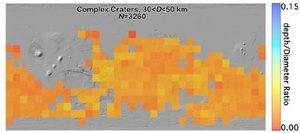
Must read! An fantastic article and a worthy theory that ties together many loose ends on the Mars-Antarctica connection. Well worth exploring this avenue further. Hats off to the author! MH
Pierre Lescaudron
Sott.net
Sat, 14 Sep 2019 18:31 UTC
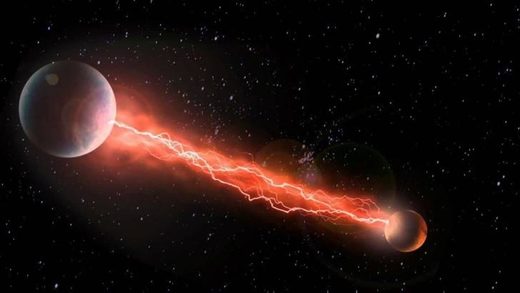
While finalizing the writing of the article titled “Of Flash Frozen Mammoths and Cosmic Catastrophes“, I encountered an unexpected anomaly.
The time of the demise of the mammoths is also known as the Younger Dryas, a period of global cooling that lasted from 12,900 to 11,700 years ago (10,900 B.C. to 9,700 B.C.) during which surface temperaturesdropped by approximately 7°C.
In theory, such a severe cooling should increase the volume of polar ice and, as a result, reduce sea level. However, during the Younger Dryas, sea levels rose 17 meters over more than a millennium, as illustrated by the graph below.
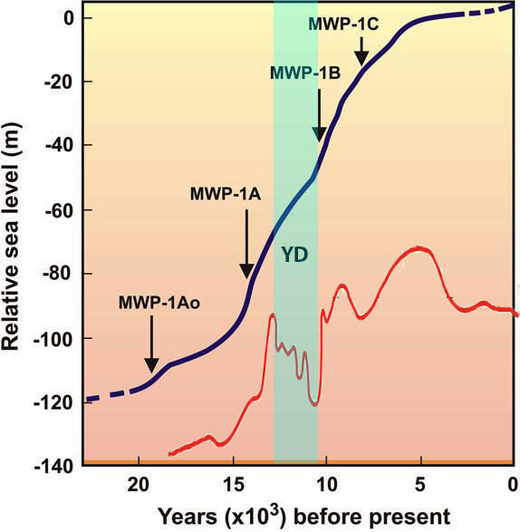
If the sea level rose while ice caps were building up, it’s possible that the source of the water was external. But where could this water have come from?
Coincidentally or not, most of Mars’ Northern hemisphere was once covered with water, and this ocean has mysteriously disappeared. So where did the Martian water go?
Sea Levels on Earth
The Younger Dryas was triggered by major meteorite impacts (c. 12,900 BP) on the Laurentide ice sheet, as described in the Frozen Mammoth article. These impacts very likely melted massive quantities of ice and led to a sea level rise. However the 1,200 years of cold temperatures that followed should have frozen at least some water and reduced sea levels, yet sea levels rose dramatically throughout those 1,200 years.
In any case, the meteorite impacts on the Laurentide ice sheet can only explain a small part of the 17 meter rise observed during the Younger Dryas.
Reconstruction of the glacial melt history finds major northward melt-water discharge 13,100-12,500 years ago, at the beginning of the Younger Dryas. The outflow entered the Arctic Ocean, via the Mackenzie River, Fram Strait, and ultimately reached the eastern North Atlantic.
Geomorphological data, on the other hand, suggest that still blocked routes to the north and east toward the St. Lawrence Seaway until the end of the Younger Dryas. Sea level curves from Tahiti, New Guinea, and Barbados show a small step (under 6 meters) around 13,000 years ago near the Younger Dryas onset, which may have come from this deluge.
~ Vivien Gornitz, Rising Seas: Past, Present, Future, p.127
According to Leverman et al., a 7°C drop in temperature should lead to a sea level drop of about 28 meters (~4 m/°C). As shown in the diagram above however, the sea level rose about 17 meters during the Younger Dryas, while the melting of the Laurentide ice sheet should have increased sea level by 6 meters.
It means that about 39 meters of extra water (17+28-6) was added on the surface of the Earth. Keep in mind that those three figures are just approximations, estimates based on a number of hypotheses. They provide us nonetheless with an order of magnitude.
Water on Mars?
Giovanni Domenico Cassini (1625-1712) In 1666, famous astronomer Cassini, through simple telescope observations, observed ice-like polar caps and clouds on Mars and concluded that there was obviously water on Mars.
Cassini’s view prevailed for a few centuries, but modern science rejected Cassini’s claim and the new doctrine became that there was no water whatsoever on Mars. It’s only recently, with the massive flow of data coming from Martian probes and rovers, that the evidence became overwhelming that Mars did indeed have water at some point in the past.
According to a paper published in Science in 2015, Mars used to hold enough water to cover its entire surface in a liquid layer about 140 meters deep. About 85% of this water has, however, “disappeared” (the remaining 15% is stored under ice at the poles).
Apparently, Martian water was not uniformly spread over the surface of the planet. According to a recent topographic study, most of the Martian water was stored on the North of the planet, in one single ocean, with a similar volume to Earth’s Arctic ocean.
If this water was somehow transferred to Earth, it would result in an approximate sea level rise of 34 meters. This figure is comparable, in terms of magnitude, to the 39 meters estimate mentioned above.
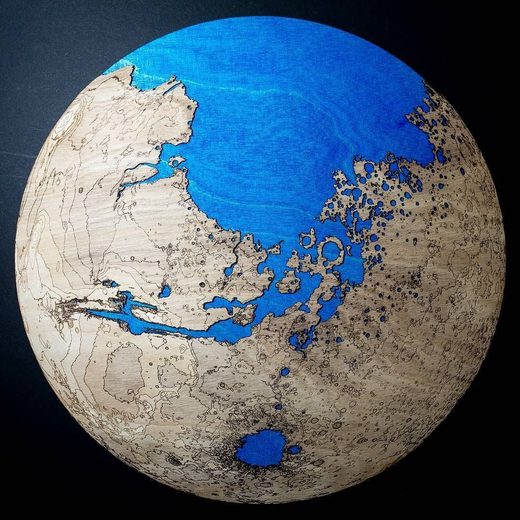
How Could Mars Lose its Water?
As noted, most water on Mars has “disappeared”. Modern science offers two explanations for this: underground leakage and space leakage.
Underground leakage is highly unlikely because Mars has no known tectonic plates and therefore no subduction, which is the main phenomenon through which surface water is brought underground.
Space leakage posits that, about 4.2 billion years ago, Mars lost its magnetic field and, devoid of this protection, solar winds stripped the planet of its atmosphere, and most of its water, within a few hundred million years.
However, this is probably not true for one simple reason: the top half of the Martian Northern hemisphere (where the Martian ocean once stood) exhibits far less and far smaller craters than the rest of the planet.
In 2011, Robbins et al published a database listing close to 400,000 craters. The picture on the right is excerpted from this paper and shows the geographic distribution of Martian craters (diameters between 30 and 50 km). Obviously, most of Mars’ Northern hemisphere exhibits a far lower concentration of craters than the rest of the planet.
If Mars’ ocean disappeared about 4 billion years ago, how can we explain that Mars’ ocean bed is almost devoid of asteroid impact evidence while the rest of the planet is covered with craters?
One potential explanation would be that most impacts on Mars happened more than 4 billion years ago, when the ocean was still there and acted as a damper, preventing the formation of craters on Mars’ surface.
However, this explanation doesn’t seem to hold up. Despite an almost non-existent atmosphere, violent dust storms occur on Mars that erode craters. Given that Robbins et al identified “well-preserved” craters on Mars, these craters must be relatively recent.
The geographic distribution of this type of crater reveals the same pattern: there are less recent craters where the Martian ocean was in comparison to the rest of the planet.
The above strongly suggests that Mars lost its water much more recently than mainstream science claims.
Interplanetary Electric Discharge
The Electric Universe theory, as described in our book Earth Changes and the Human Cosmic Connection, shows how celestial bodies (planets, starts, moons, comets, etc) are electrically charged. In addition, such bodies are surrounded by a sort of “insulation bubble” (Double Layer).
When two astronomical bodies, like two planets, get close enough, an electric discharge forms from the most negative planet to the most positive one, in order to re-balance the electric charge of the two planets. Electric discharges between celestial bodies have been observed several times. Here are a few examples:
– Between Fragment G of Comet Shoemaker-Levy and Jupiter:
The Hubble Space Telescope detected a flare-up of fragment “G” of Shoemaker-Levy long before impact at a distance of 2.3 million miles from Jupiter. For the electrical theorists this flash would occur as the fragment crossed Jupiter’s plasma sheath, or magnetosphere boundary.
Thunderbolts, Deep Impact and Shoemaker-Levy 9

– Between Io, one of Jupiter’s moons, and Jupiter:
In November 1979, the noted astrophysicist Thomas Gold proposed that the gigantic plumes on Io are not volcanic but evidence of electrical discharging.Years later, a paper by Peratt and Alex Dessler followed up Gold’s suggestion, showing that the discharges took the form of a ‘plasma gun effect,’ which produces a parabolic plume profile, filamentation of the matter within the plume, and the termination of the plume onto a thin annular ring.
W. Thornhill, The Electric Universe, p.112

– Herbig Haro Object 34. Here, electric discharges, in the form of interstellar Birkeland currents, occur between proto stars and proto planets:

Electric discharge along HH34 celestial objectsElectric discharges between celestial bodies are very similar to arc welding. When the negatively charged electrode is brought close enough to the positively charged part, an electric arc, ionized air (plasma), appears and electrons travel in the plasma (along what is called “Birkeland currents”) from the electrode (stick) to the welded part in order to re-balance the electric charges.
Notice that during arc welding, electrons are not the only material transferred from the electrode to the welded part; (negatively charged) molten metal from the tip of the electrode is carried towards the positively charged welded part.
Another typical feature of such electric discharges is “electric scarring”. These fractal patterns are known as ‘Lichtenberg figures’. Lichtenberg is the physicist that discovered this phenomenon in 1777. Notice that the polarity of the scarred material has marked influence on the form of the Lichtenberg figure:
[…] there is also a marked difference in the form of the figure, according to the polarity of the electrical charge that was applied to the plate. If the charge areas were positive, a widely extending patch is seen on the plate, consisting of a dense nucleus, from which branches radiate in all directions.
Negatively charged areas are considerably smaller and have a sharp circular or fan-like boundary entirely devoid of branches. Heinrich Rudolf Hertz employed Lichtenberg dust figures in his seminal work proving Maxwell’s electromagnetic wave theories
Relative Polarity of Mars and Earth
As described in chapter 8 of Earth Changes and the Human Cosmic Connection, in our solar system, the Sun is the most positive body. Therefore, the further away from the Sun a planet is, the more negative its electric potential is. Being further away from the Sun than Earth, Mars’ electric potential is lower than that of Earth’s.
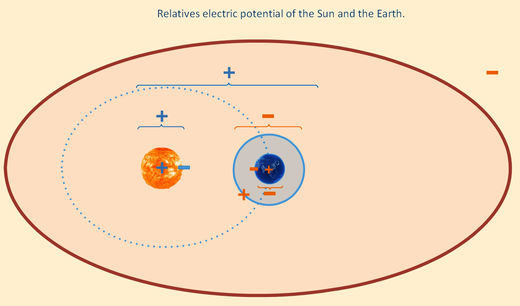
As a consequence, if an electric discharge happened between Mars and Earth, it started from the most negatively charged body (Mars) and spread towards the most positively charged body (Earth).
Mars was the cathode (negatively charged) and was stripped of material (gases, rocks, water), and the electric scarring should exhibit craters, striking at a high point, forming craters and steep-sided trenches.
If the surface is a cathode (negatively charged), the arc will tend to move across the surface. After striking, usually at a high point, and eroding a crater, the arc may jump to a new high point — the rim of the new crater is a most likely target.
The abundance of small craters centered on the rims of larger ones testifies to this predictable behavior. As the arc travels, it may erode a series of craters in a line, appearing as a chain of craters.
If the craters in these chains overlap, the effect is a steep-sided trench with scalloped edges. The arc may erode a trench for a distance and then jump some distance away before eroding another trench. These “dashed line” trenches will usually have circular ends and constant widths. All of these patterns occur in great abundance on the surface of Mars.
W.Thornhill, The Electric Universe: Part II Discharges and Scars
Signs of electric discharge on Mars
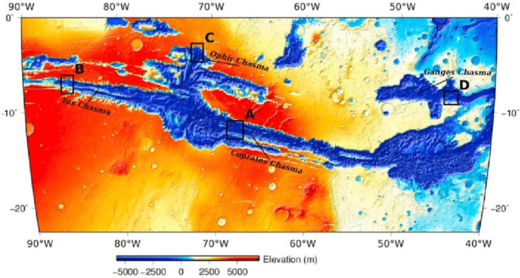
If a massive electric discharge occurred between Mars and Earth, is there any trace of a major (negative) Lichtenberg figure, as described above, to be found on Mars?
One of the main geological features of Mars is Valles Marineris. At more than 4,000 km (2,500 mi) long, 200 km (120 mi) wide and up to 7 km (4.5 mi) deep, it is the second largest canyon in the entire Solar system, and stretches for nearly a quarter of the planet’s circumference.
Mainstream science theorizes that Valles Marineris formed as a result of water erosion billions of years ago. However, this explanation doesn’t seem to match some of the characteristics of Valles Marineris:
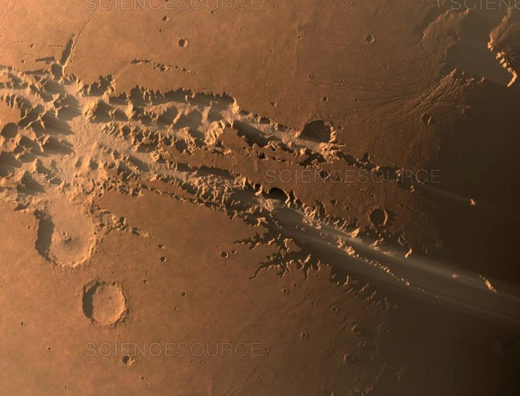
Probe photograph of Valles Marineris
- In Valles Marineris, the “outflow” is as narrow as the “inflow”, and the middle of the course constitutes its broadest part. Overall the width is quite constant, unlike rivers, which tend to broaden over their course.
- The “course” of Valles Marineris doesn’t follow the downslope. It sometimes “runs” uphill although there is no sign of the damage – rifts for example – that might be expected if the topographical changes were due to later vertical movement of the terrain.
- Valles Marineris doesn’t reveal signs of tributary “rivers”. The two major “rivers” that can be imagined run parallel to each other. The secondary “river” joins the main one at a near right angle, unlike the converging path usually exhibited by tributaries that join a main river.
- The floor of Valles Marineris reveals transverse markings, unlike river beds that tend to have longitudinal markings shaped by the river flow.
- The “tributaries” exhibit a V-shaped cross-section while water erosion typically forms U-shaped river beds.
- Valles Marineris banks are very deep (7 km) and very steep. The banks show no sign of water erosion and its typical horizontal marking. On the contrary, the markings reveal a vertical chevron pattern.
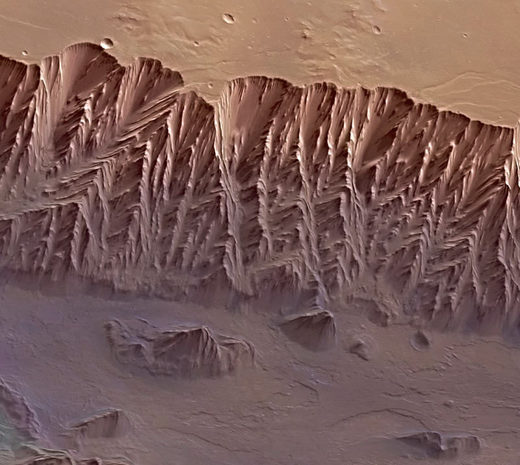
While the features of Valles Marineris seem to contradict the water erosion theory, they are very consistent with the distinctive features of (negative) electric scarring:
When planets come close, gargantuan interplanetary lightning results. It is perfectly capable of stripping rock and gases from a planet against the puny force of gravity. It does so leaving characteristic scars. […]
The parallelism of the canyons is due to the long-range magnetic attraction of current filaments and their short-range strong electrostatic repulsion.
Particularly significant are the small parallel rilles composed essentially of chains of craters. A traveling underground explosion follows the lightning streamer and cleanly forms the V-shaped tributary canyons.
There is no collapse debris associated with undercutting water flow.Similarly, the “V” cross-section is usual for craters formed by underground nuclear explosions. The circular ends of the tributaries, where the explosion began, are precisely of that shape.
In comparison, headward erosion by ground water sapping gives a U-shaped cross-section and does not necessarily end in a circular alcove.
Note that some of the tributary canyons on the south rim of Valles Marineris cut across one another at near right angles. This might be due to repeated discharges from the same area chasing the main stroke as it travelled along Ius Chasma. No form of water erosion can produce crosscutting channels like that.
The fluted appearance of the main canyon walls is probably due to the same travelling explosive action.
W. Thornhill, Mars and the Grand Canyon
Interestingly, Valles Marineris is contiguous to the ocean that once covered most of Mars’ ocean. If Valles Marineris was the location of an electric discharge between Mars and Earth, the adjacent Martian ocean would have certainly been affected, and possibly transferred.
Evidence of Material Transfer From Mars to Earth
As mentioned in the above quote, a massive electric discharge from Mars to Earth could have stripped significant quantities of rocks from Valles Marineris. So, before looking for signs of a major (positive) electric discharge on Earth, let’s see if there is any evidence of Martian rocks on Earth.
As of 2019, 237 Martian meteorites have been found on Earth, according to the Meteoritical Society. So, transfer of material from Mars has occurred.
One might assume that this phenomenon is very ancient and occurred billions of years ago when the planets were forming, and when asteroids were rampant and orbits were unstable. But data suggests that this is not exactly the case.
While the landing time for most of Martian meteorites is unknown, a few have been dated – in particular the Martian meteorite commonly abbreviated ALH84001, which was found in 1984. Its ETA on Earth has been estimated at 13,000 years ago (11,000 B.C.).
According to Hamilton et al, the origin of ALH84001 is Valles Marineris because of its geological nature (orthopyroxenite), which is the only place where orthopyroxenite has been found (via spectral analysis). In fact, ALH84001 is the only orthopyroxenite Martian meteorite. No other meteorite of this kind has been found on Earth.
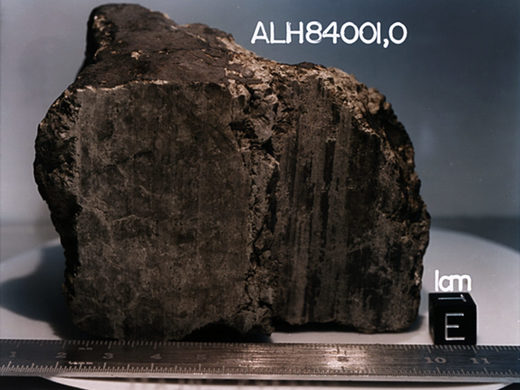
Martian meteorite ALH84001
Interestingly, because of its carbonates content, ALH84001 is the only meteorite originating from a time period during which Mars is suspected to have supported liquid water. ALH84001 is an abbreviation which stands for ALlan Hills 84001. Allan Hills is located along the southern coast of Antarctica.
Now, let’s recapitulate some key characteristics of ALH84001:
- It comes from Valles Marineris
- At the time of its arrival on earth, Mars was a wet planet
- It landed on Earth 13,000 years ago
- It was found in Antarctica
It would be interesting to know if some Martian meteorites come from its oceanic bedrock. Unfortunately, the geological composition of the oceanic bedrock of Mars is unknown because it is covered with a thick layer of sediment. However the mineralogical composition of the coast of Mars’ dry ocean is known and directly related to some Martian meteorites found on Earth.
Indeed, there is a rare type of Martian meteorite called “nakhlite”. Only 21 specimens have been found on Earth so far. Nakhlites are rich in augite (a silicium-based mineral) and they formed from basaltic magma about 1.3 billion years ago.
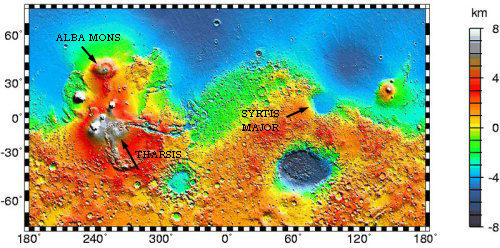
Because of the composition and age of the nakhlites, they are believed to originate from one of these three Martian volcanic areas: Tharsis, Elysium, or Syrtis Major Planum.
Interestingly, as shown in the above map, each of those three volcanic constructs is situated near the coast of what was once the Martian ocean.
Of the 21 nakhlite meteorites that reached Earth, 7 of them were found in Antarctica – that is 33%. This is a high percentage knowing that only about 12% of all meteorites that reached Earth were found in Antarctica. Mass wise, 16.9 kg of nakhlite meteorites were found in Antarctica – that is 54% of the total mass of nakhlite meteorites.
Lastly, the nakhlite meteorites are believed to have fallen to Earth up to 10,000 years ago. This figure is quite close to the arrival date of ALH84001 (13,000 years ago).
Any Sign of Electric Discharge on Earth?
If a massive electric discharge initiated from Valles Marineris and hit Earth, where did the hit occur?
There are several canyons on Earth, including the Grand Canyon, which hold features of electric scarring. However, the data about Martian meteors provided above reveals a strong affinity of Martian meteorites for Antarctica.
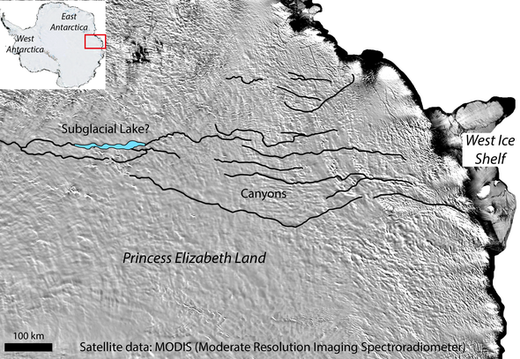
Does the bedrock of Antarctica show any sign of positive electric scarring, i.e. a massive canyon-like geological feature? Indeed it does. As shown in the satellite picture above, Antarctica is considered to host the largest canyon on Earth, according to a 2016 geological survey:
[…] the largest unsurveyed region on the icy continent is a region called Princess Elizabeth Land. Now a team of geologists has scoured that area to reveal a massive subglacial lake and a series of canyons, one of which — more than twice as long as the Grand Canyon — could rank as Earth’s largest.
At this point, Martian meteorites and traces of electric scarring point to Antarctica for a potential location for the Mars-Earth transfer. But what about the main constituent of the whole process; water?
If Mars lost most of its water to Earth, there should be some evidence of this massive transfer, on our planet in general and in Antarctica in particular.
Could part of the Antarctica ice sheet be of Martian origin? To answer this question, let’s first observe the Antarctic ice sheet and then compare it to its Arctic counterpart.
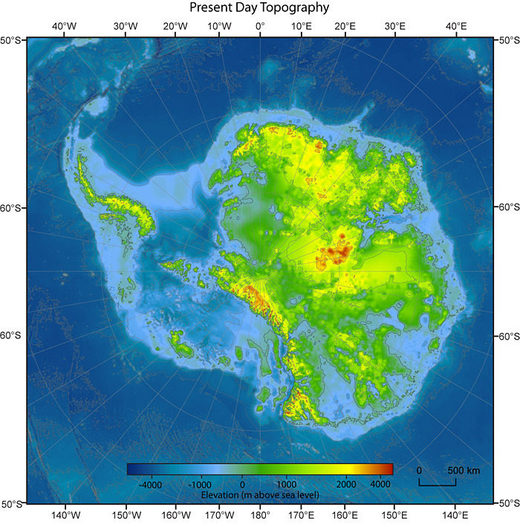
The Antarctica ice sheet is massive. It contains about 30 million km3 (7.2 million cubic miles) of ice. This represents more than 70% of Earth’s freshwater. In comparison, the arctic ice sheet, located over Greenland, is only 2.9 million km3 (0.68 million cubic miles).
In terms of volume, the Northern ice sheet is less than 10% of Antarctica’s ice sheet. Notice also that Antarctica does not form one single solid continent. It’s more like an archipelago constituting of a few massive islands separated by deep marine areas, as depicted in the map above.
Between the islands covered by the Antarctic ice sheet, the bedrock can be as low as 2,500 meters below sea level. This means that in some places the ice sheet is more than 4 km (2.7mi) thick – 1.5 km (1mi) above sea level and 2.5 km (1.7mi) below sea level (see cross section of Antarctica below).
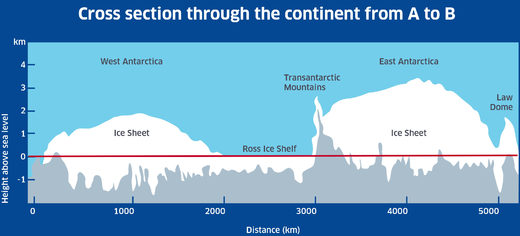
For comparison, the Arctic sea ice reaches a maximum thickness of 4 meters with ridges up to 20 meters, although the average depth of the Arctic Ocean is 1,038 meters, which is comparable to the depth of the Antarctic “ocean”.
The question then arises: why is there so much more ice in Antarctica compared to the Arctic? Why does Antarctica ice extend 2,500 meters below sea level and reach the bedrock, while Arctic ice is a mere 4 meter thick layer floating on the ocean?
According to mainstream science the Antarctic and Greenland ice sheet were formed because of the incremental accumulation of snow, year after year. This suggests that Antarctica experienced a lot more snowfall. But data shows the opposite. Indeed, Antarctica is one of the driest places on Earth, with only 18 cm/year of precipitation, while the Arctic region experiences almost double this figure with 32 cm/year.
If Antarctica receives less snow than the Arctic region, the only explanation for its tenfold higher quantity of ice is that it experiences less melting. Maybe Antarctica is experiencing much colder temperatures relative to the Arctic region? Again data suggests the opposite….READ THE REST









